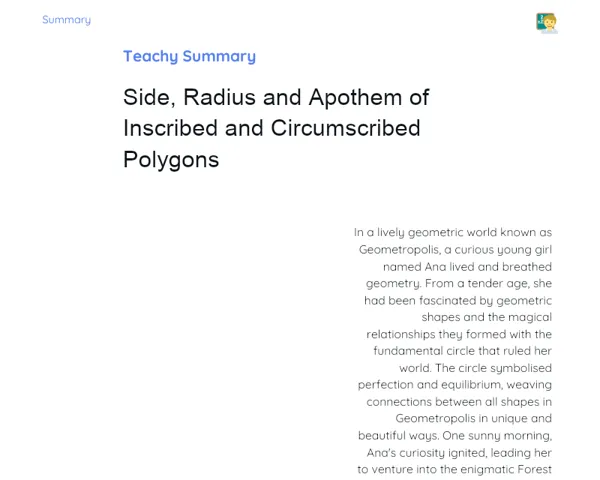Summary Tradisional | Triangles: Angular Classification
Contextualization
Triangles are basic geometric shapes that crop up in many disciplines, from mathematics to engineering and even architecture. They consist of three sides and three internal angles, where the total always adds up to 180°. Grasping the properties of triangles and how to classify them is critical for tackling geometric challenges and applying them in real-world contexts.
When studying triangles, one of the most significant classifications hinges on their internal angles. Depending on the angle measurements, triangles can be sorted into three categories: acute, right, and obtuse. This classification not only simplifies the process of identifying triangles but also enhances our understanding of their properties and practical uses. For instance, right triangles are favoured in construction due to their stability and the straightforward relationships between their sides that facilitate accurate calculations.
To Remember!
Definition of Triangles
A triangle is a geometric shape made up of three sides and three angles. The sum of the internal angles equals 180°. This characteristic is essential for classifying triangles and solving various geometric problems. Triangles are crucial in a range of fields as their properties are used in calculations and construction tasks.
Triangles can be categorised in multiple ways, but one of the key classifications is according to their internal angles. Knowing this classification helps individuals quickly identify the type of triangle and leverage the specific properties of each in different scenarios.
Furthermore, understanding the properties of triangles is vital for exploring other geometric shapes and for grasping more complex concepts in geometry. For example, many polygon-related problems can be tackled by breaking them down into triangles and applying their properties.
-
A triangle consists of three sides and three angles.
-
The internal angles of a triangle always sum to 180°.
-
Classifying triangles is essential for identifying and applying their properties.
Acute Triangle
An acute triangle is defined as one where all internal angles are less than 90°. This type of triangle is prevalent in various practical scenarios, particularly in designing structures and solving problems that necessitate acute angles.
Acute triangles are vital due to their useful properties. For example, in an acute triangle, the altitudes always fall within the shape, making it easier to compute areas and other measurements.
Additionally, acute triangles often feature in optimisation problems where one aims to maximise or minimise distances or areas. Studying these triangles leads to a deeper understanding of how acute angles affect geometric properties.
-
All internal angles are less than 90°.
-
The altitudes of acute triangles lie within the shape.
-
Commonly used in optimisation challenges and structural design.
Right Triangle
A right triangle has one internal angle that is exactly 90°. This triangle type is among the most frequently studied in geometry due to its unique characteristics and extensive applications across various fields, such as construction and trigonometry.
Right triangles are crucial for understanding metric relationships, including the sine and cosine laws. These relationships aid in calculating distances and angles in non-right triangles, expanding the practical use of this knowledge.
Moreover, right triangles play a key role in solving problems involving right angles, particularly in building sites and navigation. Grasping the properties of right triangles is essential for correctly applying trigonometric and geometric principles in real-life scenarios.
-
Contains one internal angle equal to 90°.
-
Essential for understanding metric relationships.
-
Widely applicable in construction and trigonometry.
Obtuse Triangle
An obtuse triangle is one with an internal angle exceeding 90°. Although less common than acute and right triangles, it still holds significance in various geometric applications.
Obtuse triangles possess distinct properties, such as the altitudes potentially falling outside the shape, complicating certain calculations. Nevertheless, understanding these triangles is crucial for addressing problems that involve obtuse angles.
Moreover, obtuse triangles find use in design and engineering, especially where obtuse angles are essential for specific structures. Recognising the properties of obtuse triangles enables better application of these concepts in real-life contexts.
-
Has an internal angle greater than 90°.
-
The altitudes can extend outside the shape.
-
Utilised in design and engineering for particular constructions.
Key Terms
-
Triangle: A geometric figure made up of three sides and three angles.
-
Angular Classification: A method of categorising triangles based on their internal angles.
-
Acute Triangle: A triangle in which all internal angles are less than 90°.
-
Right Triangle: A triangle that features an internal angle of exactly 90°.
-
Obtuse Triangle: A triangle that has an internal angle greater than 90°.
-
Internal Angles: Angles formed within a triangle, the total of which always amounts to 180°.
-
Properties of Triangles: Fundamental characteristics of triangles, including the total of internal angles and metric relationships.
Important Conclusions
In this lesson, we explored the significance of triangles in geometry and their diverse applications across fields like engineering and architecture. Understanding triangular properties, particularly that the sum of internal angles is consistently 180°, is fundamental for solving geometric problems. We examined the classification of triangles based on their internal angles, categorising them as acute, right, or obtuse, and underscoring the unique properties of each type.
Acute triangles, with all angles below 90°, often play a role in optimisation and structural designs. Right triangles, characterised by a 90° angle, serve as the backbone of trigonometry and civil construction. Lastly, obtuse triangles, which possess an angle greater than 90°, find their place in certain design and engineering applications. This classification aids in recognising and utilising triangle properties in practical issues.
The insights gleaned from this lesson are not only applicable to mathematical problem-solving but also enrich our understanding and application of geometric concepts in everyday life. We encourage students to delve deeper into this topic, practicing the classification of triangles and employing the properties discussed in different scenarios. Exploring the study of triangles and their characteristics is crucial for fostering analytical and geometric skills.
Study Tips
-
Practice solving problems that involve classifying triangles based on internal angles, using diverse examples to solidify your understanding.
-
Utilise geometric tools like a ruler and protractor to draw various types of triangles and measure their angles. This will help you visualise the properties discussed in class.
-
Revise trigonometric concepts related to triangles, especially metric relationships such as sine and cosine laws, to enhance your comprehension and application of triangles in more complex problems.



